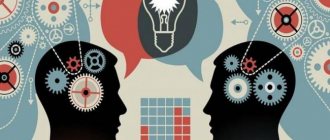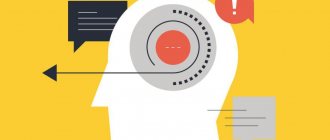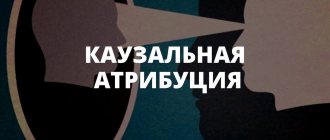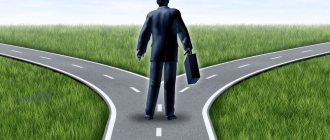Action as an element of activity
The word “element” is often associated with something small and insignificant. But if we consider that everything consists of interconnected particles, then the significance of each of them in the overall structure of the object becomes obvious. Unequal replacement, rearrangement, or loss of one element can lead to a change in the properties and qualities of the item as a whole (not always for the better).
Any work - productive or unproductive - consists of a number of individual actions arranged in a certain sequence. To obtain the intended result, a person must act systematically, rationally, using the necessary tools, devices, materials, etc. That is, such elementary parts of an activity as actions determine its success if their selection is correct and the sequence is logical. Chaoticity, redundancy or insufficiency is the cause of useless work, whatever it may be.
Declension of the noun action
| Case | Question | Unit | Mn. number |
| Nominative | (who what?) | action | actions |
| Genitive | (who, what?) | actions | actions |
| Dative | (to whom; to what?) | action | actions |
| Accusative | (who, what?) | action | actions |
| Instrumental | (by whom, what?) | action | actions |
| Prepositional | (About who about what?) | action | actions |
What is human activity
Like many representatives of the animal world, man is a doer. He is able to change and improve his own environment and living conditions as a result of work and his inherent transformative attitude towards the environment.
In nature there is no such object (living or non-living) as an “activity”: it cannot be drawn or photographed. However, activity and person do not exist separately.
Visible conscious changes in living conditions are one of its results; it is productive. The other is internal changes, self-improvement. Man, working, discovered, learned and invented new ways of developing his own mental, physiological, and mental processes. That is, being an active subject, he has the object of his transformations not only the whole world, but also himself, his society.
Activity
Actions are related to a person's overall activity in life. The more active a person is, the more actions he performs. And such people usually feel much better than passive people, they are more cheerful and optimistic, and, of course, more often achieve success in life, in a variety of things. The activity itself has a good therapeutic effect. She talks about a person’s love for life, which is a constant movement, a constant process of change. A person must live to feel good. And to live means to be active, it means to act.
Life is impossible if nothing happens and nothing changes. This is always some kind of process of change, some kind of movement. The more a person lives, the higher his activity. And the more he lives, the more alive he is, let’s say, the better he feels. And what’s most interesting is that through activity a person gets to know himself. When he takes some actions, he sees what he is capable of, what he is strong in and what he is weak in. Successful actions tell us what we already know how to do, and unsuccessful ones indicate what we need to learn. And studying is again an action through which we improve ourselves. This improvement process can be continuous. By constantly learning something, we let ourselves understand that there are no dead-end situations in this life, there is always a way out, no matter what situation we find ourselves in. We just have to learn something that we don’t know yet. That is, you can always do something to change something. It is not necessary to put up with what does not suit us. Action is the perfect key to many doors of opportunity. The more we do, the more we expand our capabilities. And the more opportunities we have, the calmer and more confident we feel, because we know that we can influence a lot in this world in order to get something or protect ourselves from something. So I believe that actions not only at the level of thoughts have a positive effect on us, but also at the level of instincts. When we move to them, we tune our minds to the struggle that makes up our whole life. At the most basic, animal level, we prove to ourselves that we deserve to live, and not just any kind of life, but a decent, high-quality life. Because an active person always deserves more, because he is ready to fight for this more and better, overcome difficulties, compete with others in order to win.
Motives and activities
What motivates people to act? This is a motive, a reason, the need to satisfy some kind of personal need (physiological, spiritual, social), pushing a person to active actions. They are formed under the influence of upbringing, social relations, culture, and customs.
What does an individual do during his life? Play, study, work - these are the main types of his activities. They are mastered gradually, as his psychophysiological development progresses. One of the types becomes predominant, which satisfies the basic needs of a person and corresponds to his capabilities. So play, being the main type of activity for a child, is replaced by educational (school, vocational education), and then work.
Peculiar types of human activity are creativity and communication.
The result of creativity is something new in science, art, and the production of material assets. The desire for communication is explained by a person’s need to satisfy both material and spiritual needs.
Developmental potential of object-tool actions
The first weeks and months of life, the child’s motor activity is characterized by undifferentiated movements; they most likely represent reflex reactions.
The first differentiated movements include hand movements, palpating and grasping - the child is already able to hold individual muscle groups in tonic tension.
At the functional level, the child’s hand becomes an element of active expansion of the space of his activity. By grasping and holding an object, the baby fixes his gaze on it. The act of grasping is formed by five months, and the foundations for the development of spatial-object perception are laid. The role of the adult during this period becomes decisive, since he creates a situation for the development of the child’s orientation in the surrounding space.
An object offered to a child causes his directed activity - to reach out, touch, grab. If a situation for manipulating an object is not created, the child will be completely absorbed in egocentric actions, such as sucking his thumb, rocking, etc.
By the beginning of the second year of life, a child’s arsenal contains a sufficient number of specific actions for imitation by an adult, however, this is only imitation, and not his own objective action.
In the second year of life, the stage of functional action begins - the child is more active and often imitates the actions of an adult, for example, talking on the phone. The action is transferred in two ways:
- transfer from one object to another - the action with a cup is transferred to the action with a glass,
- transferring an action with one object to another situation, for example, having learned to put on a sock, the baby pulls it on another object.
By mastering objective actions, the child forms their arbitrariness, which must first be felt, i.e. have a signal value. Object-tool actions and their mastery are fertile ground for the formation of visual and effective thinking.
Experimental studies by L.S. Vygotsky in the field of formation of psychological mechanisms of children's thinking, allowed us to conclude that the child's first intellectual decisions are oriented towards an adult - the child turns to the adult with requests and demands in order to achieve success.
Classification of actions (psychology)
Any type of activity is possible with the sequential implementation of specific actions. Psychology calls four types of them:
| Types of actions | Description, examples |
| Instinctive | That is, genetic, unconscious. For example, during a fire, a mother rushes to save her child, despite a mortal threat to herself (maternal instinct). Instinct can cause conscious actions - the same mother is looking for optimal means and ways of escape from a fire |
| Reflex | Reactions to irritants that are not conscious to a person: rubbing a sore spot, coughing in a smoky room |
| Impulsive | a) Unconscious reaction to surprises of any nature: the exclamation “Wow!” typical for a frightened person and for an unexpectedly happy one. b) Partially conscious impulsive actions: a person frightened during an attack takes defensive measures |
| Strong-willed | Basic, conscious actions. For example, trained to work with a book, a student correctly builds a chain of his actions: carefully read the text several times, highlight the main theme, the main characters, give them a description, etc. |
For humans, the main types of actions are volitional. A well-mannered person knows how to subordinate his instincts to his will and act reasonably thoughtfully in critical situations when an excess of emotions can partially or completely turn off rational thinking.
Sociology: classification of actions according to M. Weber
Every day a person performs so-called social actions that have the goal of influencing other people in one way or another.
According to the classification of M. Weber (sociologist, 1865-1920, Germany), there are the following types of actions:
- Purposeful, that is, having a practical goal and thoughtful means of achieving it. Such actions are organized, for example, by a doctor when treating a patient, foreseeing what complications may arise, what means of treatment and prevention should be used.
- Value-based and rational actions are caused by the moral and moral attitudes of the individual. The actions of many WWII heroes were dictated by feelings of patriotism and duty to defend the Fatherland.
- Affective - caused by strong feelings (fear, love). For example, a young man jumps off a cliff to prove his feelings to a girl.
- Traditional actions are repeated in similar situations when customs must be observed (funerals, weddings, honoring heroes, organizing and holding holidays).
According to Weber, a person’s actions are dictated by his personal motives and his expectation of the reaction of others (approval, condemnation).
Responsibility
But ideas of passivity that are hostile to us take root in people’s heads and of their own free will. We ourselves are often happy to refer to anyone and anything, explaining our failures and passivity, just to do nothing ourselves. But at the same time, many of us do not understand that we are deceiving not someone else, but ourselves, by refusing to lead an active lifestyle. This desire to shift all your problems and worries onto someone else is an absolutely false sense of ease. A person’s life will definitely not change for the better from such a position. How can life be easy if you are not the master of it? Well, if a person doesn’t do anything, what will he get from it? He will retain his strength, he will preserve himself a little better, but for what? We will not all live forever, no matter how much we mess around. And our health depends not on how much we do, but on what exactly we do.
No, there are and cannot be any excuses for passivity and laziness. When we are lazy, we simply do not understand how life works, why it was given to us. One of the meanings of life is to do something. Waiting for something or just observing means giving up a full life. Therefore, of course, with such a discrepancy between a person’s internal mood and the very idea of life, he will feel bad. Likewise, depression can come and all sorts of self-destructive thoughts can come, such as the desire to enjoy things that are harmful to health, such as alcohol and drugs. Passivity is a destructive state. And people are often infected with it on purpose in order to gain power over them. And people themselves choose a passive life because of their lack of understanding of it. We must not refuse responsibility, but accept it and even strive for it in order to live a full life and have power at least over ourselves. Then the person will feel much happier. After all, taking responsibility for your life is the path to a free life. And a free life is the path to happiness.
Action as a form of action
Actions, like a mirror, reflect the moral essence of a person, since they are dictated by a conscious choice between “good” and “bad.” This form of action is a component of behavior that is consistent or inconsistent with the rules and norms accepted in society.
Any action has its own purpose and implementation plan, dictated by the person’s intentions. Its consequences do not always coincide with those expected, and it is characterized as rash and frivolous.
The action can be expressed:
- directly in physical action (picking up a fallen object and giving it to the person who dropped it);
- verbal (support with a word, approve or condemn someone);
- in demonstrating attitudes to events, to other persons, to their actions, words (irony, gesture, body movements, gaze);
- inaction (failure to comply with orders from a superior, failure to provide assistance to someone in distress).
An action is inevitably assessed from the outside in accordance with the moral standards accepted in society (or group). Even theft, for example, can be approved in an asocial environment, as a sign of dexterity and fearlessness.
A person is certainly responsible for any activity, for his actions, even if its prospects seem unclear or distant.
Connection with other words
Words ending with -action:
- inaction
- performance
- interaction
- impact
- macro action
- aftereffect
- opposition
- radio countermeasures
- servo action
- assistance
Hypo-hyperonymic relationships
action set service
What are the actions (adjectives)?
Selection of adjectives for words based on the Russian language.
military combat further active any similar decisive magical enemy side hostile retaliatory investigative first healing offensive necessary joint strong other any strange certain beneficial reverse destructive last possible specific necessary subsequent other own next violent second successful desired basic arithmetic ordinary independent illegal unexpected criminal calming aggressive immediate opposite rash physical simple magical real illegal some fast habitual perfect direct amazing depraved practical ritual
What can action do? What can you do with the action (verbs)?
Selection of verbs for words based on the Russian language.
happen begin to cause unfold appear produce look develop accomplish join seem end have render appear move lead transport demand remain take go lead stay unfold call continue be end occupy observe go play out manage bring begin last follow cost remind make introduce go treat accompanied compose wear come die follow end appear lie discuss lead participate appear have to speak end demand be transferred follow pass
Associations to the word action
side attitude case territory composition condition help rear sea region Germany organism quality goal Europe during Chechnya Russia progress defense future front Poland north scene limit arrival land moment connection land France year past theme east end salvation mountain man Japan Moscow air beginning space distance point war field deputy application fight correspondence west frame Italy action planet region Afghanistan battle Finland enemy
Synonyms for action
act gait battle influence influence dressing trick doing business brainchild occupation manufacturing product execution manipulation skill fraud need operation implementation fruit feat preparation craft deed gait enterprise drug refuge preparation shelter shelter work production profession procedure process work implementation craft handicraft collection transaction investigation case equipment creation dispute court essence labor litigation refuge device fabrication fabrication move step maneuver
Hyponyms for action
- complementation mark wheeze excavation favor cough growl reprisal commission delegation payment solution device ID cough in a row ending reflection intersection mobilization alienation ironing cut calibration chasing citation vandalism cut gravy weaving simplification exhortation charging designing notification dive donation interruption reception sight set powder dash help solution bill direction organization act baking dissipation failure dacha contribution fencing smoking decoction rowing allocation order information fence performance impact ceremony escape consolation writing vault resistance complaint retelling bombing settlement procession fertilizer rollback engagement barter trick drilling start castling
- execution activity team population feat login multiplication division
- lunge baiting thing departure
- measure
Scope of use of the word action
Military term Technology General vocabulary Medicine Legal term
Types of actions in educational activities
Each generation is forced to master the experience, knowledge, skills that were lost with the previous one, that is, it must learn. With the development of science and technology, with the renewal of social processes, the content, forms, and methods of teaching are modified, and new types of educational activities appear.
In modern society, good general and special education is highly valued. For a person, it is an open door to the most interesting world of professionals, and for society it guarantees the emergence of highly qualified and creative personnel capable of leading it along the road to progress.
The educational activities and types of actions of teachers and students differ because their functions differ: the former give knowledge, and the latter receive. The educator, teacher, parents, lecturer teach, that is, they are active subjects of this process. The objects of learning - pupils, students, participants in various courses - assimilate the concepts given to them and types of actions (mental, practical).
Education is a complex, long-term process that requires not only high-quality training, but also gradual and conscious mastery of educational activities and skills in working with information.
Solving cognitive problems is certainly accompanied by the development of students’ personal qualities. That is, by the end of training they must sufficiently master actions aimed at self-education, self-development, establishing communication connections and determining their place in society. A detailed list of them is presented in the Federal State Educational Standard.
Legal and non-legal actions
The activities of law enforcement agencies are aimed at protecting the rights of citizens in accordance with the legislation adopted in the country.
Types of legal actions are determined on different grounds. For example, according to legislation, they can be divided into the following groups:
- legal, that is, corresponding to the rules of law: buying or selling real estate, going to court to protect one’s interests, etc.;
- unlawful, contrary to the law: various crimes, intentional and unintentional offenses.
Legal actions are carried out not only by lawyers, but also by workers in other fields of activity. For example, in order to certify that a business traveler has arrived at the enterprise, it is not necessary to go to the justice authorities: this will be done in the personnel department. Or: the marriage certificate is issued at the place of its registration in the registry office.
Man and other people
Social arena Of course, you are not in the theater or in the circus. You are not an actor and certainly not a clown. You are you. And you know about yourself (I wonder where from?) that you are this and that, you think that you have such and such principles and your discretion - your worldview portrays the world to you this way and that way. And all this is true, but only until the audience appears in front of you. The light falls on you - and you are visible, your voice sounds - and you are heard, your movements are observed... Are you really on stage? Who you are? And who are the audience? Where... Social psychology Socio-psychological thinking Person Other People
Sources
- https://www.SunHome.ru/psychology/deystviya-cheloveka
- https://psichel.ru/dejstvie/
- https://FB.ru/article/459014/ponyatie-i-vidyi-deystviy-v-deyatelnosti-cheloveka
- https://psychologist.tips/712-deyatelnost-cheloveka-chto-eto-v-psihologii-vidy-deyatelnosti-i-ih-harakteristika.html
- https://www.calc.ru/Ponyatiye-I-Klassifikatsiya-Deystviy-Cheloveka.html










